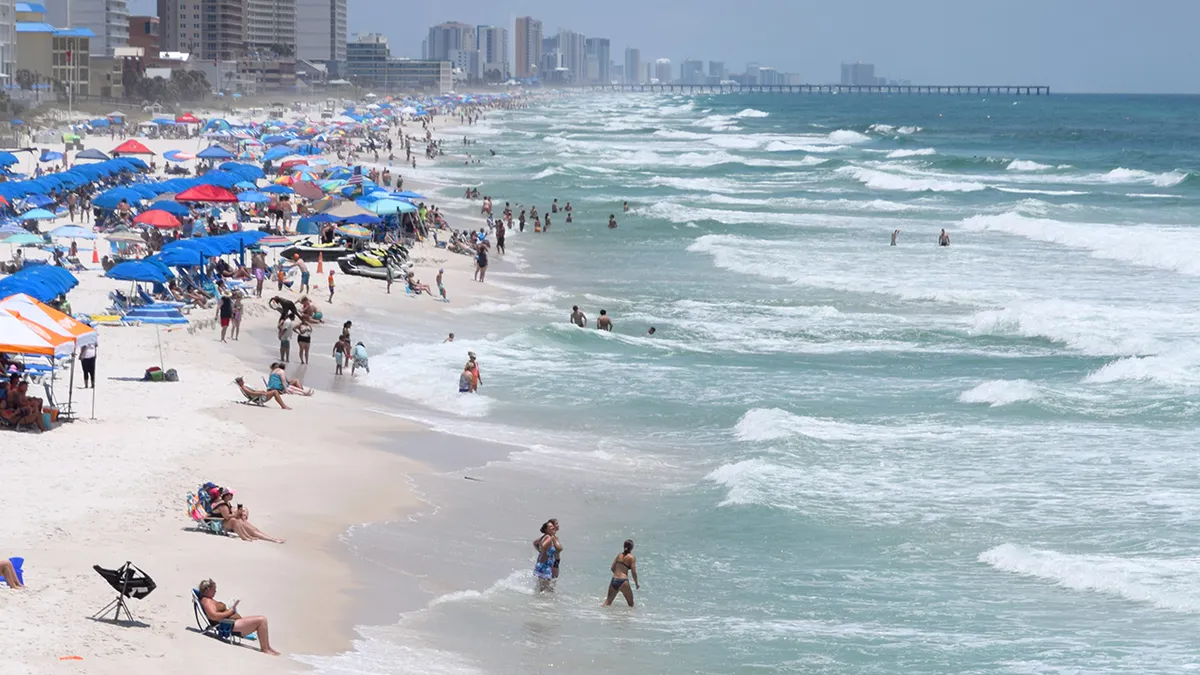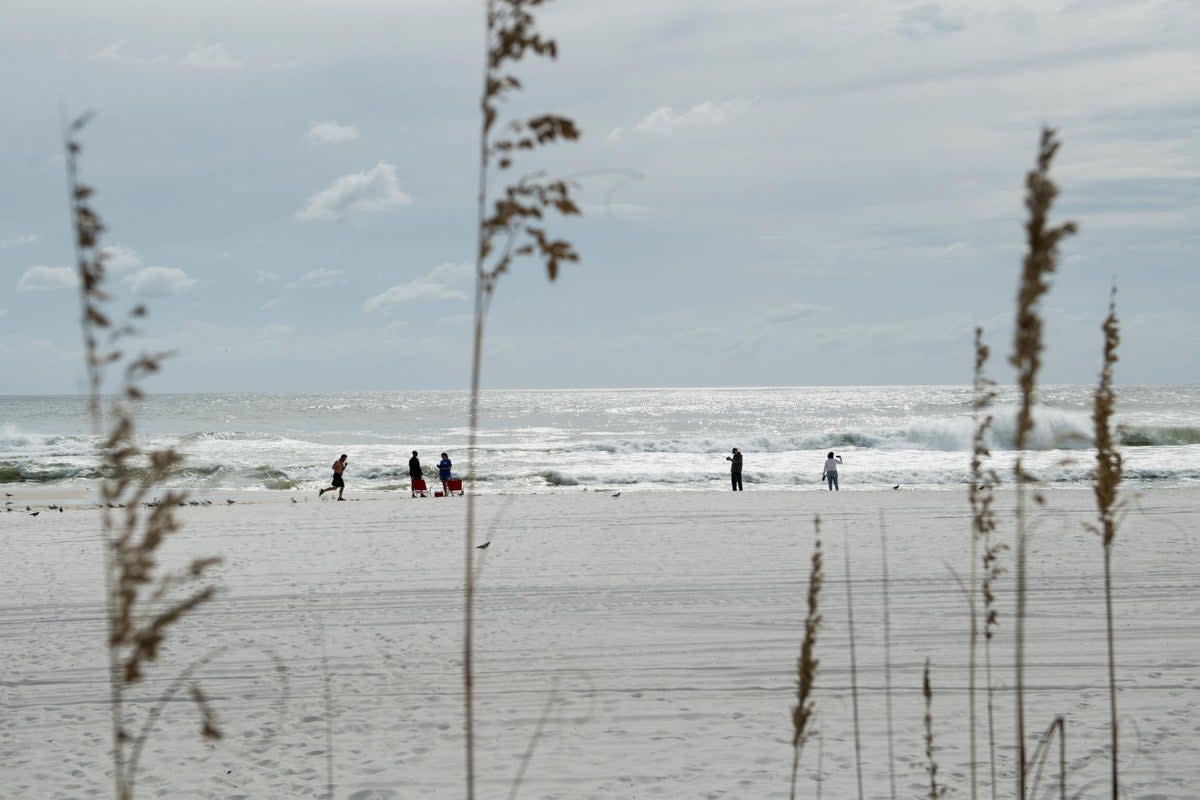Current Dynamics

Panama city beach rip current – Rip currents are powerful, narrow channels of fast-moving water that flow away from the shore, often through breaks in the sandbar. They can occur at any beach, but they are particularly common in Panama City Beach due to the unique combination of factors that contribute to their formation.
The rip currents of Panama City Beach are as unpredictable as the Giants vs Cubs prediction. They can pull you under in an instant, leaving you struggling for breath. But even the strongest rip current can be overcome if you know what to do.
Just like in baseball, where the underdog can sometimes pull off an upset, you can survive a rip current if you stay calm and think clearly.
The formation of rip currents begins with waves breaking on the beach. As the waves break, they create a current that flows back towards the ocean. This current is called the longshore current. If the longshore current is strong enough, it can create a rip current.
The rip currents at Panama City Beach are relentless, their deceptive allure luring swimmers into a dangerous dance with the sea. Yet, amidst the chaos, a beacon of hope emerges in the form of the Padres vs Phillies game, its electric atmosphere providing a distraction from the relentless waves.
Even as the rip currents pull and push, the roar of the crowd reverberates through the air, reminding us that life’s struggles can be overcome with determination and the unwavering support of our community.
Rip currents are typically located near jetties, piers, and other structures that disrupt the flow of the longshore current. These structures create eddies, which are circular currents that can trap water and create a rip current.
The relentless Panama City Beach rip current is a force to be reckoned with, its deceptive calm concealing a dangerous undertow. Like the ebb and flow of the tides, our attention shifts to the thrilling giants vs cubs prediction , where the battle for supremacy unfolds on the baseball diamond.
Yet, as the game reaches its climax, our gaze returns to the unforgiving ocean, where the rip current’s relentless pull serves as a poignant reminder of the perils that lie beneath the surface.
Rip currents can also be caused by changes in the underwater topography. If there is a sudden drop-off in the depth of the water, it can create a rip current. Rip currents can also be caused by changes in the wind direction. When the wind blows offshore, it can create a rip current.
The rip currents at Panama City Beach are no joke. They can pull even the strongest swimmers out to sea in a matter of seconds. Just last week, a group of tourists had to be rescued after they were caught in a rip current.
Thankfully, they were all wearing life jackets, which helped to keep them afloat until help arrived. If you’re planning on swimming at Panama City Beach, be sure to wear a life jacket and swim in a designated swimming area. You can also check the beach conditions before you go swimming by visiting the brewers vs angels last game.
Rip currents are more likely to occur when the waves are high and the wind is strong. So, if you see any of these conditions, it’s best to stay out of the water.
Strength and Frequency, Panama city beach rip current
The strength and frequency of rip currents can vary depending on a number of factors, including the size of the waves, the strength of the longshore current, and the underwater topography. Rip currents are typically strongest during high tide and when the waves are large. They are also more common during storms.
Visual Representation
The following table provides a visual representation of rip current patterns and their potential locations.
The rip currents at Panama City Beach can be treacherous, but they’re not the only thing to watch out for. The Angels and Brewers are set to face off in a crucial game tonight, and the outcome could have a major impact on the AL West standings.
With both teams coming off of wins, this is sure to be a close one. But if the Angels can pull out a victory, they’ll take a big step towards securing a playoff spot. So if you’re looking for something to do tonight, be sure to tune in to the game.
You won’t be disappointed.
| Location | Rip Current Pattern |
|---|---|
| Near jetties | Rip currents are often located near jetties, which are structures that extend into the ocean. Jetties disrupt the flow of the longshore current, which can create eddies and rip currents. |
| Near piers | Rip currents are also often located near piers, which are structures that extend out into the ocean. Piers create eddies, which can trap water and create a rip current. |
| Near other structures | Rip currents can also be located near other structures, such as groins and breakwaters. These structures disrupt the flow of the longshore current, which can create eddies and rip currents. |
| Changes in underwater topography | Rip currents can also be caused by changes in the underwater topography. If there is a sudden drop-off in the depth of the water, it can create a rip current. |
| Changes in wind direction | Rip currents can also be caused by changes in the wind direction. When the wind blows offshore, it can create a rip current. |
Safety Precautions
Navigating Panama City Beach’s allure requires an acute awareness of rip currents and the safety measures that can safeguard your aquatic adventures. Heed these crucial tips to minimize risks and ensure a carefree beach experience.
When venturing into the ocean, remain vigilant for warning signs and flags. Heed the guidance of lifeguards, who are trained to monitor conditions and provide assistance in case of emergencies. Familiarize yourself with the beach’s topography, identifying safe swimming areas and potential hazard zones.
Lifeguards and Warning Systems
Lifeguards play a pivotal role in preventing rip current accidents. Their watchful eyes scan the water, identifying potential hazards and intervening promptly. Warning flags and signs alert swimmers to dangerous conditions, providing valuable information to guide their decisions.
- Green flag: Safe swimming conditions.
- Yellow flag: Moderate risk; exercise caution.
- Red flag: High risk; swimming is prohibited.
- Double red flag: Extreme risk; stay out of the water.
Safety Measures and Recommended Actions
By adhering to safety precautions, you can significantly reduce the likelihood of encountering rip currents or minimize their impact if caught in one. Remember these essential guidelines:
| Safety Measure | Recommended Action |
|---|---|
| Swim near a lifeguard | In case of an emergency, help is readily available. |
| Learn to identify rip currents | Observe the water’s surface for choppy, discolored, or foamy areas. |
| Don’t swim alone | Having a companion provides an extra layer of safety. |
| If caught in a rip current, stay calm | Panicking can lead to exhaustion and further danger. |
| Swim parallel to the shore | Do not attempt to swim directly back to shore; this will only exhaust you. |
| Signal for help | Wave your arms or call out to attract attention. |
Forecasting and Monitoring: Panama City Beach Rip Current

To ensure the safety of beachgoers, Panama City Beach employs advanced technologies and data sources to forecast and monitor rip currents in real time. These systems provide valuable information to lifeguards and beachgoers, helping them identify and avoid dangerous conditions.
Observational Methods
Trained lifeguards play a crucial role in monitoring rip currents through regular beach patrols. They observe the water’s surface for signs of turbulence, discoloration, or debris movement, which can indicate the presence of a rip current.
Technology and Data Sources
In addition to visual observations, Panama City Beach utilizes a combination of technologies and data sources to enhance rip current monitoring:
- Buoys: Oceanographic buoys are deployed offshore to collect real-time data on wave height, wind speed, and direction. This data is used to create predictive models that forecast rip current activity.
- Cameras: High-resolution cameras are installed along the beach to provide a constant visual feed of the water’s surface. Trained personnel monitor these cameras and alert lifeguards to any potential hazards.
- Current Meters: Current meters are placed in strategic locations to measure the speed and direction of water currents. This data helps lifeguards identify areas where rip currents are likely to form.
Effectiveness and Impact
The combination of observational methods, technology, and data sources has significantly improved the accuracy of rip current forecasting and monitoring in Panama City Beach. These systems provide lifeguards with real-time information, allowing them to quickly respond to dangerous conditions and warn beachgoers of potential hazards. As a result, the number of rip current-related incidents has been drastically reduced, making Panama City Beach a safer destination for swimmers and water enthusiasts.
